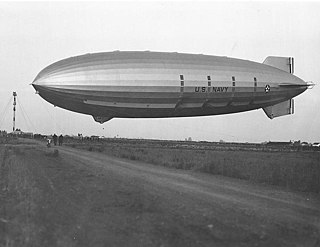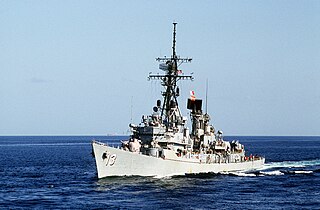Ship commissioning is the act or ceremony of placing a ship in active service and may be regarded as a particular application of the general concepts and practices of project commissioning. The term is most commonly applied to placing a warship in active duty with its country's military forces. The ceremonies involved are often rooted in centuries-old naval tradition.

USS Akron (ZRS-4) was a helium-filled rigid airship of the U.S. Navy, the lead ship of her class, which operated between September 1931 and April 1933. It was the world's first purpose-built flying aircraft carrier, carrying F9C Sparrowhawk fighter planes, which could be launched and recovered while it was in flight. With an overall length of 785 ft (239 m), Akron and her sister ship Macon were among the largest flying objects ever built. Although LZ 129 Hindenburg and LZ 130 Graf Zeppelin II were some 18 ft (5.5 m) longer and slightly more voluminous, the two German airships were filled with hydrogen, and so the two US Navy craft still hold the world record for the largest helium-filled airships.

USS Patrick Henry (SSBN-599), named after the American Revolutionary War figure and Founding Father Patrick Henry (1736–1799), was a George Washington class nuclear-powered fleet ballistic missile submarine of the United States Navy. She was later converted into an attack submarine and redesignated SSN-599.

USS Thresher (SSN-593) was the lead boat of her class of nuclear-powered attack submarines in the United States Navy. She was the U.S. Navy's second submarine to be named after the thresher shark.

USS Virginia (CGN-38) was a nuclear-powered guided missile cruiser, the lead ship of her class, and the eighth ship of the United States Navy to be named for the Commonwealth of Virginia. She was commissioned in 1976 and decommissioned in 1994.

USS Arkansas (CGN-41) was a Virginia-class nuclear-propelled guided-missile cruiser of the U.S. Navy. She was in commission from October 1980 through July 1998. Her primary missions were in defending aircraft carrier task forces in air defense (AAW) and antisubmarine warfare (ASW) by using her guided missiles, radar systems, and sonar systems. Since Arkansas had the high speed and unlimited range provided by her nuclear reactors, she usually escorted the nuclear-powered aircraft carriers of the U.S. Navy.

USS Triton (SSRN/SSN-586), the only member of her class, was a nuclear powered radar picket submarine in the United States Navy. She had the distinction of being the only Western submarine powered by two nuclear reactors. Triton was the second submarine and the fourth vessel of the United States Navy to be named for the Greek god Triton, At the time of her commissioning in 1959, Triton was the largest, most powerful, and most expensive submarine ever built at $109 million excluding the cost of nuclear fuel and reactors.

USS Hoel (DDG-13), named for Lieutenant Commander William R. Hoel USN (1824–1879), was a Charles F. Adams-class guided missile destroyer.

Edward Latimer Beach Jr. was a highly decorated United States Navy submarine officer and best-selling author.

USS Von Steuben (SSBN-632), a James Madison-class fleet ballistic missile submarine, was the second ship of the United States Navy to be named for Baron Friedrich Wilhelm von Steuben (1730–1794), a Prussian army officer who served in the American Revolutionary War.

USS Tautog (SSN-639), a Sturgeon-class attack submarine, was the second ship of the United States Navy to be named for the tautog, a wrasse commonly found along the Northern Atlantic coast. The submarine was in service from 17 August 1968 to 31 March 1997.

SS Imperator was a German ocean liner built for the Hamburg America Line, launched in 1912. At the time of her completion in June 1913, she was the largest passenger ship in the world by gross tonnage, surpassing the new White Star liner Olympic.

USS Pioneer (MCM-9), an Avenger-class mine countermeasures ship of the United States Navy, and is the ninth ship of the class, and the second Navy ship of that name.

USS Vreeland (FF-1068) was a Knox-class frigate of the United States Navy. The ship was named for Rear Admiral Charles E. Vreeland (1852–1916).

A sea trial is the testing phase of a watercraft. It is also referred to as a "shakedown cruise" by many naval personnel. It is usually the last phase of construction and takes place on open water, and it can last from a few hours to many days.

USS Shelton (DE-407) was a John C. Butler-class destroyer escort built for the United States Navy during World War II. Named for Ensign James A. Shelton,, she was the first of two U.S. Naval vessels to bear the name.
USS Wheatear (AM-390) was an Auk-class minesweeper acquired by the United States Navy for the dangerous task of removing mines from minefields laid in the water to prevent ships from passing.
USS Passaconaway (YN-114/AN-86) – sometimes called USS Skakamaxon -- was a Cohoes-class net laying ship which was assigned to protect United States Navy ships and harbors during World War II with her anti-submarine nets. Her World War II career was short due to the war coming to an end, but, post-war, she continued salvage operations, including those at Bikini Atoll, before being struck from the Navy in 1947.

The second USS Benicia (PGM-96/PG-96) was a Asheville-class gunboat in the United States Navy commissioned in 1970. She later served in the South Korean Navy as Paek Ku 51 (PGM-351).

Operation Sandblast was the code name for the first submerged circumnavigation of the world, executed by the United States Navy nuclear-powered radar picket submarine USS Triton (SSRN-586) in 1960 under the command of Captain Edward L. Beach Jr.

















